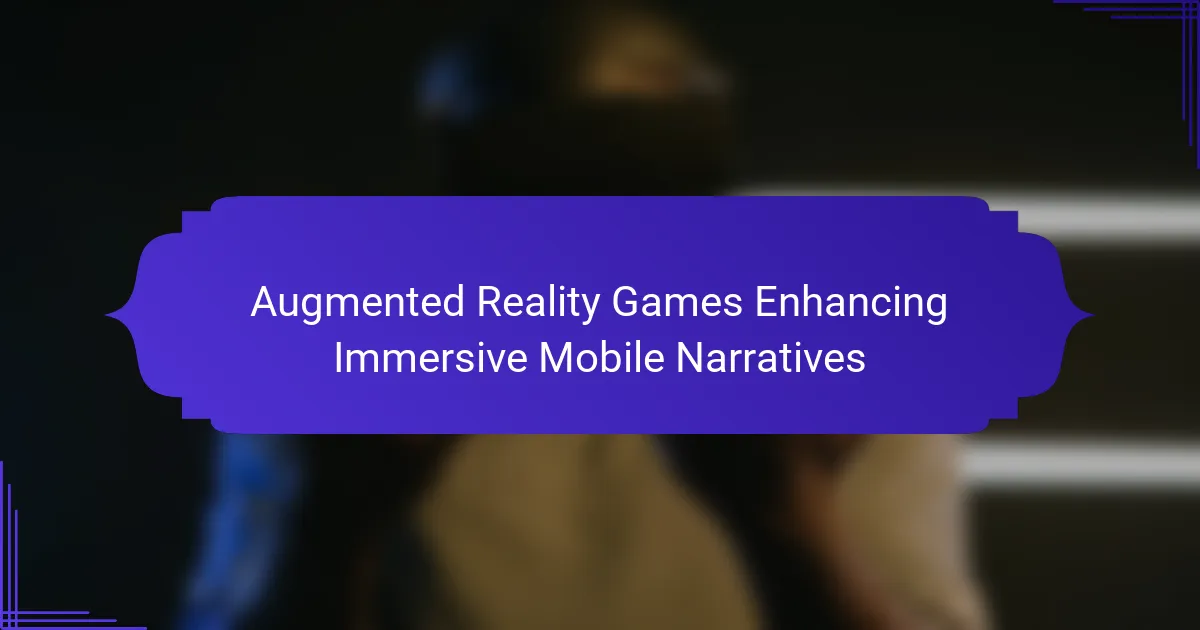Augmented reality games significantly enhance mobile narratives by integrating interactive elements into real-world environments. This article explores how these games foster deeper engagement, utilize location-based features, and create emotional connections through personalized experiences. Additionally, it examines the technologies powering these immersive experiences and the unique features that distinguish successful augmented reality games. Finally, it addresses the challenges developers face and the trends shaping the future of augmented reality in mobile storytelling.

How do augmented reality games enhance mobile narratives?
Augmented reality games enhance mobile narratives by integrating interactive elements into real-world environments. This technology fosters deeper engagement, allowing players to experience stories in immersive ways.
These games utilize location-based features, enabling narratives to unfold in specific physical spaces. Players interact with characters and events that blend seamlessly with their surroundings, creating a unique storytelling experience.
Moreover, augmented reality enhances emotional connections through personalized experiences. Players often form attachments to characters appearing in their immediate environment, making the narrative more impactful.
Incorporating gamification elements, such as challenges and rewards, further enriches the narrative experience. This approach encourages exploration and interaction, enhancing the overall storytelling dimension of mobile games.
What are the key elements of immersive storytelling in augmented reality?
Immersive storytelling in augmented reality games relies on interactivity, narrative depth, and sensory engagement. Key elements include user agency, where players influence story outcomes, and environmental integration, which seamlessly blends digital content with the real world. Emotional resonance is crucial, as stories evoke feelings that enhance connection. Additionally, multi-sensory experiences, such as sound and haptic feedback, deepen immersion. Unique attributes like location-based narratives create personalized experiences, while rare attributes, such as adaptive storytelling, adjust narratives based on player choices. These elements collectively enhance mobile narratives, making them more engaging and memorable.
Why is user engagement critical in augmented reality gaming?
User engagement is critical in augmented reality gaming because it enhances player immersion and retention. High engagement levels lead to deeper emotional connections with the narrative. This engagement is driven by interactive elements, real-world integration, and social features that encourage collaboration. As a result, players are more likely to return, increasing the game’s longevity and success. Engaged players often share their experiences, expanding the game’s reach through word-of-mouth and social media.

Which technologies power augmented reality games?
Augmented reality games are powered by technologies such as computer vision, simultaneous localization and mapping (SLAM), and depth tracking. These technologies create immersive experiences by blending digital content with the real world.
Computer vision enables devices to recognize and interpret their surroundings, allowing for interactive elements in gameplay. SLAM technology helps in accurately mapping environments while tracking the player’s position, enhancing the realism of the experience. Depth tracking adds a layer of spatial awareness, allowing virtual objects to interact with real-world surfaces.
Together, these technologies facilitate engaging narratives and gameplay mechanics, making augmented reality games a unique and evolving form of entertainment.
How does computer vision contribute to augmented reality experiences?
Computer vision significantly enhances augmented reality experiences by enabling real-time object recognition and interaction. This technology allows games to overlay digital content seamlessly onto the physical world, creating immersive narratives. For instance, computer vision can track player movements and gestures, facilitating dynamic gameplay that adapts to the user’s environment. Additionally, it enhances realism by accurately mapping virtual objects to real-world surfaces, improving user engagement and immersion.
What role does GPS play in location-based augmented reality games?
GPS is crucial for location-based augmented reality games as it provides real-time positioning data. This technology allows players to interact with virtual elements overlaid onto the real world. Accurate location tracking enhances the immersive experience by ensuring that game narratives align with physical surroundings. Furthermore, GPS enables dynamic gameplay, as players can explore different environments and engage with location-specific content. This integration of GPS not only enriches the narrative but also fosters social interactions among players in shared spaces.

What are the benefits of using augmented reality in mobile narratives?
Augmented reality in mobile narratives enhances user engagement and interaction. It creates immersive experiences that blend digital elements with the real world. This technology allows for personalized storytelling, enabling users to influence outcomes based on their actions. Additionally, augmented reality can improve information retention by providing visual context, making narratives more memorable. The unique attribute of augmented reality lies in its ability to transform static content into dynamic experiences, fostering deeper emotional connections with the narrative.
How does augmented reality improve user immersion?
Augmented reality enhances user immersion by blending digital elements with the real world, creating interactive experiences. This technology allows players to engage with narratives in a more visceral way, facilitating emotional connections. For example, location-based augmented reality games utilize real-world environments to drive story progression, making the experience feel personal and immediate. As a result, users are more likely to become deeply invested in the gameplay and narratives presented.
What psychological effects do augmented reality games have on players?
Augmented reality games can enhance players’ psychological well-being by fostering social connections and improving cognitive skills. These games create immersive experiences that engage users in novel ways. Players often experience increased motivation and satisfaction through interactive narratives. Additionally, augmented reality can reduce stress and anxiety by providing an escape from reality.

Which unique features distinguish successful augmented reality games?
Successful augmented reality games feature unique elements that enhance user engagement and immersion. Key distinguishing features include real-world integration, interactive storytelling, social connectivity, and adaptive gameplay mechanics.
Real-world integration allows players to interact with their physical environment, creating a seamless blend between the digital and tangible worlds. Interactive storytelling engages players through narrative choices that affect game outcomes, enhancing emotional investment. Social connectivity fosters collaboration and competition among players, enriching the gaming experience. Adaptive gameplay mechanics adjust challenges based on player skill, ensuring a personalized and dynamic experience.
How do narrative choices impact gameplay in augmented reality games?
Narrative choices significantly enhance gameplay in augmented reality games by creating deeper emotional connections and immersive experiences. Engaging narratives motivate players to explore their environments and interact with game elements.
For example, a storyline that evolves based on player decisions can lead to unique gameplay experiences. This personalization increases replayability and keeps players invested. Additionally, integrating local landmarks into the narrative fosters a sense of place, making the gameplay more relatable and engaging.
As a result, strong narratives in augmented reality games can transform mundane activities into captivating adventures, enhancing overall player satisfaction.
What innovative gameplay mechanics are found in leading augmented reality titles?
Leading augmented reality games incorporate innovative gameplay mechanics that enhance immersive mobile narratives. These mechanics include location-based interactions, real-time object recognition, and collaborative multiplayer experiences.
Location-based interactions allow players to engage with their environment, making gameplay contextually relevant. Real-time object recognition enables the game to respond to physical objects, creating a seamless blend of the virtual and real worlds. Collaborative multiplayer experiences foster social interactions, enhancing narrative depth through shared adventures and challenges.
These mechanics contribute to a dynamic storytelling experience, making augmented reality games uniquely engaging.

What challenges do developers face in creating augmented reality experiences?
Developers face several challenges in creating augmented reality experiences, including technical limitations, user interface design, and content integration. Technical limitations involve hardware constraints and software compatibility, which can hinder performance. User interface design must be intuitive to ensure seamless interaction, while content integration requires high-quality visuals and engaging narratives. Additionally, ensuring user safety and privacy poses unique challenges in augmented reality environments.
How do technical limitations affect the design of augmented reality games?
Technical limitations significantly impact the design of augmented reality games by constraining graphics, interactivity, and user experience. Hardware capabilities dictate the quality of graphics and responsiveness. Limited processing power can lead to lag, affecting immersion. Additionally, battery life constraints restrict prolonged gameplay, influencing game design choices. Connectivity issues may hinder real-time interactions, limiting multiplayer features. Developers must creatively navigate these challenges to enhance player engagement and narrative depth.
What user accessibility issues arise with augmented reality gaming?
Augmented reality gaming presents several user accessibility issues, including visual impairments, limited mobility, and cognitive challenges. These issues can hinder engagement and enjoyment, making it essential for developers to incorporate inclusive design practices. For instance, users with visual impairments may struggle with on-screen elements that lack sufficient contrast or text alternatives. Additionally, players with limited mobility may find it difficult to interact with physical environments required by some AR games. Cognitive challenges can arise from complex game mechanics or overwhelming sensory input, which can alienate certain users. Addressing these accessibility issues is crucial for creating immersive experiences that cater to a diverse audience.

Which trends are shaping the future of augmented reality in mobile narratives?
Augmented reality games are revolutionizing mobile narratives by enhancing interactivity and engagement. Key trends shaping this future include the integration of real-world environments, personalized storytelling, and social connectivity.
Real-world integration allows players to interact with their surroundings, creating immersive experiences. Personalized storytelling tailors narratives based on user preferences and actions, making each experience unique. Social connectivity fosters collaboration and competition, enhancing community engagement.
These trends are supported by advancements in AR technology, such as improved graphics and faster processing capabilities. As a result, augmented reality games are becoming more accessible and appealing to a broader audience.
How are advancements in AI influencing augmented reality storytelling?
Advancements in AI significantly enhance augmented reality storytelling by creating more interactive and personalized experiences. AI algorithms analyze user behavior and preferences, tailoring narratives to individual players. This personalization increases engagement and emotional connection with the story. Additionally, AI-driven content generation allows for dynamic storylines that adapt in real-time, making each gameplay unique. The integration of natural language processing enables players to interact with characters more naturally, further immersing them in the narrative. Overall, AI advancements are transforming augmented reality games into richer, more immersive mobile narratives.
What emerging platforms are integrating augmented reality for enhanced narratives?
Several emerging platforms are integrating augmented reality to enhance mobile narratives. Notable examples include Niantic’s Lightship, which allows developers to create AR experiences that blend the digital and physical worlds. Similarly, Snap’s Lens Studio enables creators to design immersive stories through AR lenses. Facebook’s Spark AR offers tools for storytelling via interactive filters. Additionally, platforms like Roblox are incorporating AR features to deepen user engagement in narrative-driven games. These innovations leverage AR to create unique, interactive experiences that captivate users.

How can developers optimize user experience in augmented reality games?
Developers can optimize user experience in augmented reality games by enhancing interactivity and immersion. Focus on intuitive controls, realistic graphics, and seamless integration with real-world environments. User feedback loops are essential for continuous improvement. Additionally, adaptive difficulty levels can cater to diverse player skills. Engaging narratives that evolve based on player choices further enrich the experience.
What best practices should be followed for designing engaging narratives?
To design engaging narratives in augmented reality games, focus on immersive storytelling that captivates players.
Incorporate dynamic character development, allowing players to influence outcomes through choices. Use environmental storytelling to create rich, interactive worlds that respond to player actions. Integrate multimedia elements, such as sound and visuals, to enhance emotional engagement.
Utilize feedback loops to keep players invested, rewarding exploration and decision-making. Ensure narratives are accessible yet layered, catering to diverse player experiences while maintaining a cohesive storyline.
Which common mistakes do developers make in augmented reality game design?
Developers often make several common mistakes in augmented reality game design that hinder immersive experiences. These include neglecting user interface clarity, failing to optimize for varied environments, and overlooking user feedback.
1. Ignoring the importance of intuitive controls can frustrate players, reducing engagement.
2. Not accounting for different lighting conditions can negatively affect the visibility of virtual elements.
3. Overloading users with information can lead to confusion, detracting from the narrative.
4. Failing to test on multiple devices may result in performance issues that disrupt gameplay.
5. Underestimating the need for a compelling story can diminish the game’s emotional impact.
By addressing these issues, developers can create more engaging and enjoyable augmented reality games.
What strategies can enhance player retention in augmented reality games?
To enhance player retention in augmented reality games, developers should focus on immersive storytelling, community engagement, and personalized experiences. These strategies create a deeper connection and encourage ongoing participation.
Incorporating rich narratives allows players to feel invested in the game world. Regular updates and events foster community interaction, making players feel part of a larger group. Personalization through tailored content keeps the gameplay relevant to individual preferences, enhancing player satisfaction.
Additionally, implementing reward systems can motivate players to return. Gamification elements, such as achievements and leaderboards, encourage competition and engagement. These strategies collectively improve retention rates and create a loyal player base.
